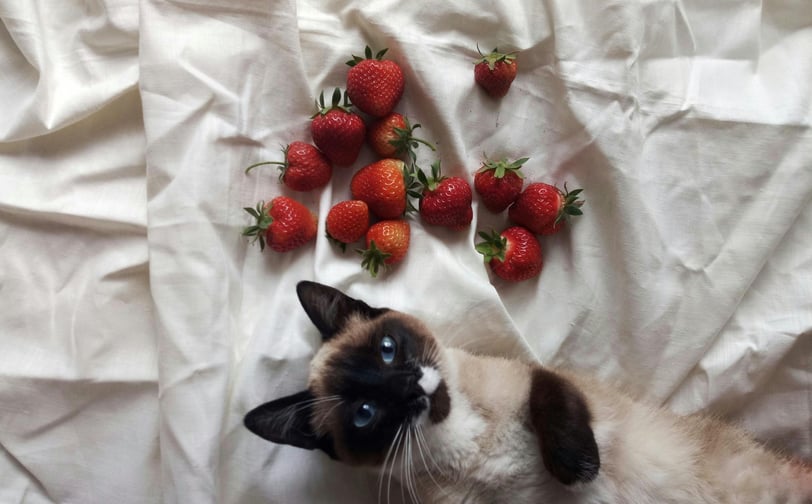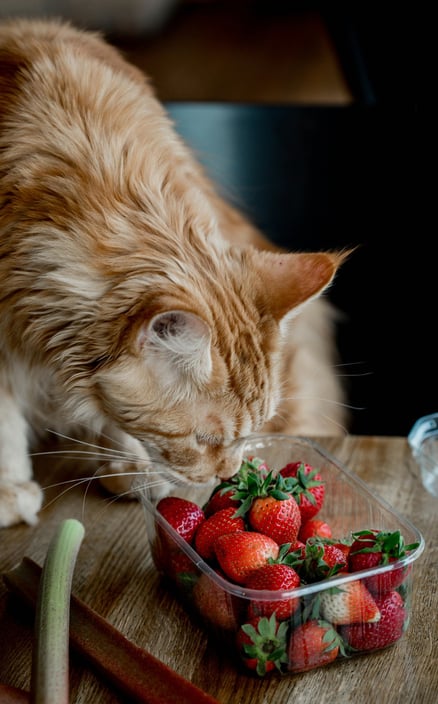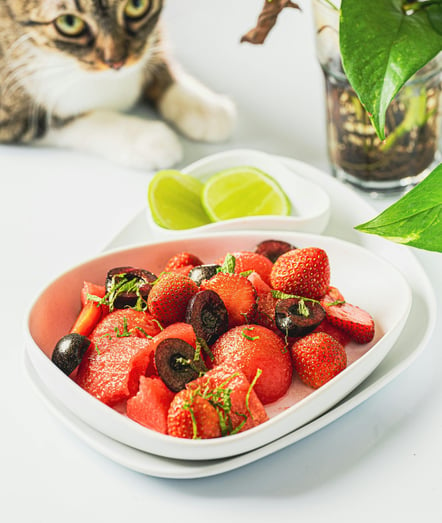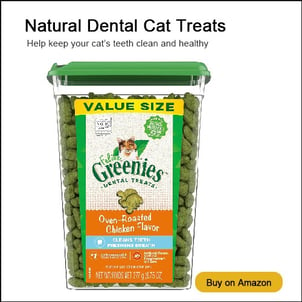Can Cats Eat Strawberries?
8/28/20244 min read


As pet parents, we often find ourselves wondering if the foods we enjoy are safe for our feline friends. Strawberries, with their bright color and sweet taste, are a popular treat for humans, but can cats eat strawberries? The answer is yes, but with some important considerations. In this article, we’ll explore the benefits and potential risks of feeding strawberries to your cat, as well as how to introduce this fruit safely into their diet.


This site contains product affiliate links. We may receive a commission if you make a purchase after clicking on one of these links at no cost to you.
Are Strawberries Safe for Cats?
Strawberries are generally safe for cats to eat in small quantities. They are non-toxic to felines and do not contain any harmful substances that could pose an immediate risk. However, while strawberries are safe, they are not a necessary part of a cat's diet. Cats are obligate carnivores, meaning their bodies are designed to thrive on a diet primarily composed of meat. Fruits and vegetables, including strawberries, do not provide essential nutrients that cats need.
Nutritional Benefits of Strawberries for Cats
While strawberries are not essential for cats, they do contain some nutrients that can be beneficial in small amounts. Strawberries are rich in vitamin C, antioxidants, and fiber. Vitamin C supports the immune system, while antioxidants help combat free radicals in the body, potentially reducing the risk of certain diseases. The fiber in strawberries can also aid in digestion, though cats typically do not require a high-fiber diet.
Potential Risks of Feeding Strawberries to Cats
Despite their benefits, there are some potential risks associated with feeding strawberries to your cat:
Sugar Content: Strawberries contain natural sugars, which can be problematic for cats if consumed in large quantities. Cats have a low tolerance for sugar, and excessive intake can lead to obesity, diabetes, or other health issues.
Allergic Reactions: Although rare, some cats may be allergic to strawberries. If you notice any signs of an allergic reaction, such as itching, swelling, or gastrointestinal upset, discontinue feeding strawberries and consult your veterinarian.
Choking Hazard: Strawberries are larger than a typical cat treat, so it's important to cut them into small, manageable pieces to reduce the risk of choking.
How to Safely Introduce Strawberries to Your Cat's Diet
If you decide to offer strawberries to your cat, start with a small piece to see how they react. Here are some tips for introducing strawberries safely:
Wash Thoroughly: Before feeding strawberries to your cat, make sure to wash them thoroughly to remove any pesticides or contaminants.
Cut into Small Pieces: Slice the strawberry into small, bite-sized pieces to prevent choking and make it easier for your cat to eat.
Monitor Your Cat: Observe your cat for any signs of discomfort or allergic reaction after consuming strawberries. If your cat shows any adverse symptoms, avoid feeding them strawberries in the future.
Moderation is Key: Only offer strawberries as an occasional treat. They should not replace your cat’s regular diet of high-quality cat food that meets their nutritional needs.
Conclusion
While cats can eat strawberries, they should only do so in moderation and as an occasional treat. Strawberries are safe and non-toxic, but they do not provide essential nutrients for your cat's diet. Always introduce new foods carefully and consult your veterinarian if you have any concerns. Remember, the best diet for your cat is one that is balanced, nutritious, and tailored to their specific needs.
By being mindful of what your cat eats, you can help ensure they live a happy and healthy life. So, the next time you’re enjoying a bowl of fresh strawberries, you can feel comfortable sharing a small piece with your furry friend—just be sure to do so responsibly!


Disclaimer: The information provided in this article is intended for general guidance and educational purposes only. It is not a substitute for professional veterinary advice, diagnosis, or treatment. Always consult your veterinarian or a qualified pet care professional regarding any concerns or questions about your cat's health and well-being.
Related Articles
Purrfect Meow
Join our Meow community
© 2024. All rights reserved.
PurrFectMeowSeven is a participant in the Amazon Services LLC Associates Program, an affiliate advertising program designed to provide a means for sites to earn advertising fees by advertising and linking to Amazon.com. As an Amazon Associate, we earn from qualifying purchases.













